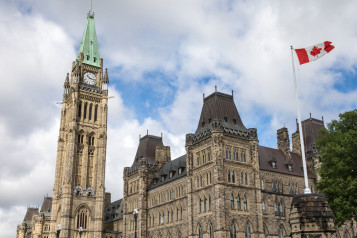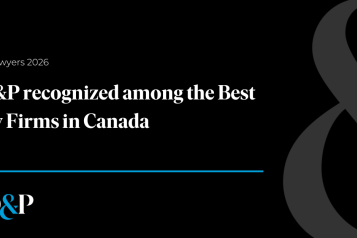Publication
Competition Bureau Releases Final Greenwashing Guidelines

Published June 10, 2025
On June 5, 2025, the Competition Bureau (the Bureau) released its final guidelines (Final Guidelines) on the application of the new greenwashing provisions under the Competition Act (CA), which came into force in June 2024. The Final Guidelines are the culmination of a comprehensive two-phase public consultation process conducted over the past year, following the enactment of the new provisions and the release of the Bureau’s draft guidelines (Draft Guidelines).
BD&P submitted detailed comments to the Bureau in both September 2024 and February 2025 urging greater clarity on the interpretation and enforcement of the new rules and recommending additional measures to enhance transparency and mitigate unintended consequences.
Similar to BD&P's comment letters to the Bureau, the focus of this article is on the applicability of the new section 74.01(1)(b.2). This section prohibits businesses from making statements to the public for promotional purposes with respect to the benefits of a business or business activity for protecting or restoring the environment or mitigating the environmental and ecological causes or effects of climate change that is not based on adequate and proper substantiation in accordance with internationally recognized methodology (IRM).
While the Final Guidelines offer clarity in certain areas, several key questions remain unresolved. It is unlikely that these clarifications will be sufficient to overcome the concerns of many businesses given the significant penalties that can be imposed and the private rights of action that will come into effect on June 20, 2025.
Clarifying Aspects of the Final Guidelines
Below provides an overview of certain elements of the Final Guidelines which assist in decoding the new provisions. These expanded areas of guidance may provide clarity and comfort to businesses making environmental claims.
More clearly defined definition of "recognized"
One of the most challenging aspects of section 74.01(1)(b.2) is the requirement to substantiate environmental claims in accordance with IRM. We have strongly encouraged the Bureau to provide a clearer definition of this term. While the Draft Guidelines provided some guidance on the meaning of "internationally recognized", the guidance was not particularly helpful:
Internationally recognized: The Bureau will likely consider a methodology to be internationally recognized if it is recognized in two or more countries. Further, the Bureau is of the view that the [CA] does not necessarily require that the methodology be recognized by the governments of two or more countries.
The Draft Guidelines begged the question: if governments do not need to recognize the methodology who does?
The Final Guidelines clarify that "recognized" refers to being acknowledged as valid, with such recognition potentially originating from a range of sources, including standard-setting bodies, regulatory authorities, or industry groups employing internationally accepted methodologies.
More clearly defined role of Bureau in private actions
Another complex issue arising in the draft guidelines was the Bureau’s role in relation to private applications brought directly to the Competition Tribunal (Tribunal), which will become available as of June 20, 2025. While it was previously understood that the Bureau could intervene once leave had been granted for a complaint to proceed, there was uncertainty regarding its potential involvement at earlier stages.
The Final Guidelines clarify that the Bureau may make submissions to the Tribunal in response to an application for leave filed by a private party. This development is significant for businesses concerned about the risk of vexatious or unsubstantiated claims. Although the Bureau’s guidance is not legally binding and does not constrain the Tribunal’s discretion, this clarification offers reassurance. If a business adheres to the Bureau’s guidance yet still faces a complaint, the Bureau may support the appropriateness of the company’s substantiation methodology during the Tribunal’s leave determination process.
Support for Canadian government-recommended methodologies
Since the introduction of the new rules, stakeholders have questioned whether methodologies required or recommended by federal and provincial regulatory reporting frameworks for making environmental claims would be considered internationally recognized methodologies given they may not be "recognized in two or more countries". The Draft Guidelines did not provide Canadian businesses with any assurance that such methodologies would be considered IRM and cautioned businesses to do their due diligence to ensure that they did.
The Final Guidelines clarify that "it is unlikely that the Bureau will pursue enforcement action under paragraph 74.01(1)(b.2) if an advertiser has followed … a methodology [required or recommended by federal, provincial or territorial government programs in Canada for the substantiation of environmental claims], provided that the chosen methodology provides adequate and proper substantiation for the claim."[1]
No Movement from the Draft Guidelines to the Final Guidelines
While the above clarifications are helpful, the Final Guidelines do not fully resolve the ambiguity surrounding the scope and application of the new rules.
Meaning of IRM remains unclear
Although the Final Guidelines separately clarify the meaning of the terms "internationally recognized" and "methodology", they do not provide over-all guidance on the scope and meaning of IRM, other than to provide that it must be "adequate and proper" and "sufficiently rigorous to establish the claim in question". Phrases such as the Bureau is "likely" or "unlikely" to recognize a methodology, that third-party verification "may" enhance claim credibility, or that businesses "should" avoid making certain types of claims, the Final Guidelines lack the definitive guidance necessary to instill confidence. Although it is understandable that the Bureau seeks to preserve enforcement discretion, greater specificity in key areas would have significantly enhanced the utility of the Final Guidelines for Canadian businesses.
Caution required when making aspirational and forward-looking statements
Stakeholders have emphasized the need for clear guidance on how businesses can make forward-looking or aspirational environmental claims without becoming targets for greenwashing complaints. Unlike other aspects of the new rules, this issue does not require novel regulatory frameworks – securities regulators and companies subject to securities laws are already well-versed in the legal standards governing forward-looking statements, which are well-established in securities law. It is therefore surprising that the Bureau has not adopted similar approaches to the application of the new rules. Instead, the Bureau will hold businesses making environmental claims about the future to a higher legal standard. We anticipate that businesses may continue to withdraw from previously stated net-zero targets and similar commitments until the higher legal standard is more clearly defined and understood.
No relief for tech startups
Numerous comment letters submitted during the public consultation period requested both clarity and flexibility in the application of the new rules, to smaller or early-stage companies. This includes companies operating in emerging technology sectors such as clean tech startups.
These businesses often operate with limited resources and tighter margins. Especially if privately held, they should not be expected to meet the same complex reporting and compliance standards as large, publicly traded entities. Imposing such requirements could create disproportionate burdens that hinder their growth and viability.
Moreover, many emerging technologies, particularly those aimed at improving the efficiency and reducing the environmental impact of existing Canadian energy infrastructure (e.g., emissions-reduction technologies), may not lend themselves to traditional forms of substantiation. The Final Guidelines recognize that a business may require reliance on multiple IRMs to substantiate a claim for a new technology, which creates further compliance burdens on them. But the fact remains that the representations tech start-ups wish to make to investors for funds to prove their technologies may not be capable of being substantiated by an IRM at all. Innovation inherently involves experimentation and uncertainty, and overly rigid rules around forward-looking claims risk stifling the very innovation these rules should support.
For these reasons, the lack of tailored guidance or accommodations for startups and innovators may inadvertently discourage investment and progress in critical areas of environmental and technological advancement.
A Step Backwards
Communications with investors and stakeholders for "another purpose"
Despite an extensive consultation process and the submission of thousands of pages of comments from the public, the Bureau appears to have misunderstood one of the most critical questions raised by stakeholders: namely, how the new rules will apply to representations made to the public outside of traditional advertising contexts.
In the Draft Guidelines, the question posed was "My business is required or encouraged to file certain environmental information with government bodies, such as securities regulators. These filings are often public. Will this contravene the [CA]?" The Draft Guidelines suggested that the new rules "were focused on marketing and/or promotional representations, not representations made for a different purpose, such as to investors and shareholders in the context of securities filings." This statement suggested that "representations to investors and shareholders in the context of securities filings" was an illustrative example of "representations made for a different purpose" (i.e. a purpose other than marketing and/or promotion). The Bureau was asked to clarify whether documents such as environmental, social and governance (and similar voluntary corporate) reports (ESG Reports) (which are not currently required to be filed with securities regulators) or other types of investor presentations, including those accessible through a businesses' website, would be considered "marketing and/or promotional representations" and would thus be subject to the new greenwashing provisions.
Instead of responding to these requests for clarification, the Final Guidelines reframe the question originally asked, suggesting that the new rules are not intended to apply to representations made by publicly traded companies that provide voluntary and obligatory information to current and potential investors of securities under "evolving frameworks for the voluntary and mandatory communication of certain environmental information to current and prospective securities investors".
This response raises several concerns. First, the Final Guidelines suggest that representations made by private companies to investors and shareholders will not benefit from such "evolving frameworks" for voluntary communication of environmental information to their investors or prospective investors. Second, there are currently no provincial or territorial frameworks specifically governing ESG reports; such reports are commonly produced by both public and private companies, and they are not specifically prepared in the context of the sale of securities. Third, the Bureau reiterated that if publicly traded companies reuse such claims to promote a product or business interest outside the context of selling securities, the Bureau will apply the new rules as appropriate.[2]
The Bureau's reframing of the question and its ambiguous response introduce further uncertainty and risk for companies publishing such disclosures, rather than providing the clarity that stakeholders have repeatedly requested.
Takeaways
While the public had hoped for greater clarity in the Bureau’s Final Guidelines, we must now work within the framework that has been provided. In the coming weeks, we anticipate gaining further insight into which types of environmental claims are most likely to attract scrutiny, as well as how the Bureau and Tribunal apply the new rules. In the meantime, if you require guidance on navigating the new greenwashing provisions of the CA, please contact any member of our Competition Law group or Business Law group.







